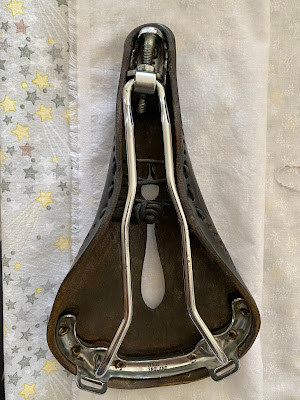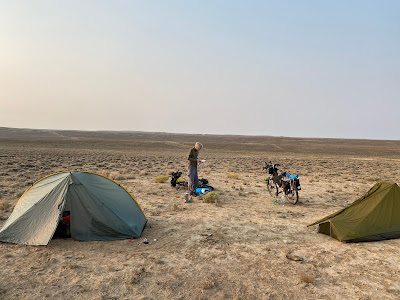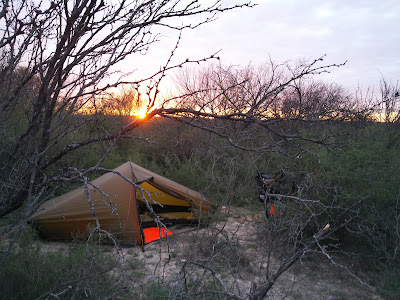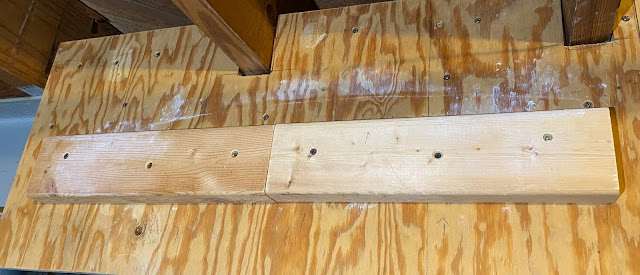 |
| Breakfast on the GDMBR, l-r: Doug, Mike |
For bikepackers, the lighter their meals on wheels, the better—as long as the food they choose provides the energy they need to continue pedaling.
There are three basic food-packing strategies for bike packers.
Some veteran bikepackers, in the interests of shaving ounces from their loads, do much of their dining at the sometimes widely-dispersed restaurants and convenience stores along the way. During these stops, they stock up on enough sandwiches, snacks and other cold fare to get them to the next resupply point. This approach lets them travel without stoves, fuel and other cooking gear.
Other bikepackers bring stoves but try to limit the weight of their own kits by relying mostly on commercially prepared freeze-dried fare for their meals.
Still other cyclists, like me, also bring stoves and other cooking supplies but put together most of their own meals, either in advance or on the fly.
I feel that my homemade meals provide me with more energy—and are less expensive—than the commercially prepared freeze-dried meals.
A five-day supply of my homemade provisions is the most I have carried. For longer trips, I send general delivery resupply caches to post offices along the route.
To keep the weight of my homemade bikepacking meals down, I rely mostly on dry ingredients: oatmeal, dehydrated vegetables and beans, instant brown rice, pasta or noodles and instant potatoes.
My standard bikepacking breakfast starts with a tablespoon of instant coffee mixed with an envelope of cocoa mix.
I add two packets of instant oatmeal, three tablespoons of instant milk (I have been using nonfat but am planning to switch to dried whole milk for the extra calories), and an envelope of vanilla-flavored instant breakfast.
If I am in a hurry to get down the road, I just soak this mixture in cold water while I am packing camp and consume it cold, without firing up the stove.
After I finish the oatmeal, I fill my pot with water and a packet of Emergen-C, a vitamin-infused powdered beverage. This helps clean the pot and gets me down the road, without wasting water. (I have learned not to waste water during a bike-packing tour, particularly when, as is often the case, I have to find it, filter it or purify it.)
For lunch, I usually just snack on whatever I have been able to scrounge up in convenience stores along the route. I particularly like tortillas (preferably whole wheat) slathered with peanut butter and honey and/or bananas. Cheese, jerky, chocolate milk and fig bars are also great options.
My go-to bikepacking dinner starts with a packet of tuna as an appetizer.
For the main course, I combine 1/2 cup of instant brown rice with a couple of tablespoons of dehydrated beans and veggies in water, and either a packet of NongShim gourmet Ramen (definitely worth the extra price) or a spoonful of Massel stock powder. I also usually add a couple of tablespoons of instant potatoes to the mixture.
This concoction fills my belly and gives me good energy the next day.
On the advice of other touring cyclists, I am planning to start adding a generous dash of coconut oil to my breakfasts and a similar amount of olive oil to my evening meals.
In addition, I plan to start adding some fresh veggies, including sauteed onions, bell peppers and garlic, to my dinners.
 |
| Kitchen at Mosquito Lake, MT, GDMBR |
I have also been sold on the concept of downing a shot of decent whiskey after dinner, largely for the additional calories.
Other combinations I intend to add to the dinner menu in the future include red lentils with quinoa and presoaked green lentils with instant brown rice.
Fresh fruits and vegetables, Subway sandwiches, and other restaurant fare, are great additions to the touring bikepacker’s diet, and these are often available in trailside towns.
On the recommendation of Mike Evanoff, a bike touring veteran who accompanied me on a section of the Great Divide Mountain Bike Route last summer, I plan to start adding dried berries, raisins and nuts to my oatmeal breakfasts.
 |
| Jim Ketcham-Colwill fixing dinner south of Pinedale WY, GDMBR |
“I keep the brown sugar separate, and add a packet of coconut oil once it (oatmeal) is cooked,” Evanoff says.
“I just bring the mix to a boil, simmer for a minute and then put the pot into a cozy to sit for a while.
Dried whole milk is another good ingredient to add if you are so inclined.”
You won’t regret eating as well as possible on your own rides. Good meal choices will not only help ensure that you are physically capable of completing your tour but may also enhance the prospects that you will enjoy the journey.
 |
| Dave Green enjoying predawn breakfast on the TransVirginia |

















